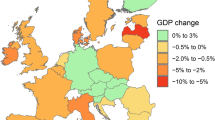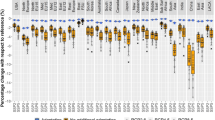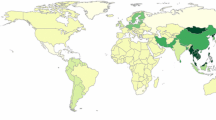Abstract
This paper develops a modelling framework that links GEMINI-E3, a multi-regional, multi-sectoral computable general equilibrium model with a cost-benefit analysis approach at local level using geographical information system tools to assess the physical and economic consequences of sea-level rise (SLR) in the twenty first century. A set of future scenarios is developed spanning the uncertainties related to global warming, the parameters of semi-empirical SLR estimates, and coastal developments (cropland, urban areas and population). The importance of incorporating uncertainties regarding coastal development is highlighted. The simulation results suggest that the potential development of future coastal areas is a greater source of uncertainty than the parameters of SLR itself in terms of the economic consequences of SLR. At global level, the economic impact of SLR could be significant when loss of productive land along with loss of capital and forced displacement of populations are considered. Furthermore, highly urbanised and densely populated coastal areas of South East Asia, Australia and New Zealand are likely to suffer significantly if no protective measures are taken. Hence, it is suggested that coastal areas needs to be protected to ameliorate the overall welfare cost across various regions.








Similar content being viewed by others
Notes
Coastal segments are independent from each other and vary in length, hence the larger the length of coastal segment, the greater the cost of protection.
All information about the model can be found at http://gemini-e3.epfl.ch, including its complete description.
Note that the BAU concentration profile is computed by the climate module of GEMINI-E3 whose carbon cycle model differs from the one used for RCPs. Thus, even if BAU and RCP emissions are close, the BAU concentration profile differs from the RCP6.
For more details refer to http://eros.usgs.gov/#/Find_Data/Products_and_Data_Available/gtopo30.
For more details refer to http://www.iiasa.ac.at/web-apps/tnt/RcpDb/dsd?Action=htmlpage&page=welcome.
Like other general equilibrium models, GEMINI-E3 assesses the welfare cost of scenarios through the measurement of the households surplus. We give the welfare change in absolute value (i.e. US $) but also in relative term by dividing it by the household consumption. To compare our results with those of other published studies that use other economic indicators, it should be noted that in these scenarios the welfare change divided by household consumption is close to the percentage change of household consumption, the relative prices being not significantly affected by the sea-level rise.
Refer to http://esa.un.org/unpd/wup/index.html.
Note that in this report the coastal areas were defined as areas between 50 m below mean sea level and 50 m above the high tide level or extending landward to a distance of 100 km from shore, including coral reefs, intertidal zones, estuaries, coastal aquaculture, and seagrass communities. While this definition will not be appropriate for all regions, it suffices to calculate an uncertainty range for global average elasticities used in this study.
References
Ackerman F, Stanton EA (2011) Climate economics: the state of the art. Stockholm Environment Institute Institute-U.S. Center, Somerville. http://sei-us.org/Publications_PDF/SEI-ClimateEconomics-state-of-art-2011.pdf
Anthoff D, Nicholls RJ, Tol RSJ (2010) The economic impact of substantial sea-level rise. Mitig Adapt Strateg Global Change 15(4):321–335
Barbier EB, Hacker SD, Kennedy C, Koch EW, Stier AC, Silliman BR (2011) The value of estuarine and coastal ecosystem services. Ecol Monogr 81(2):169–193
Bernard A, Vielle M (2008) GEMINI-E3, a general equilibrium model of international national interactions between economy, energy and the environment. Comput Manag Sci 5(3):173–206
Black R, Arnell NW, Neil AW, Thomas D, Geddes A (2013) Migration, immobility and displacement outcomes following extreme events. Environ Sci Policy, 27, Supplement 1(0):S32–S43
Bosello F, De Cian E (2013) Climate change, sea level rise, and coastal disasters. a review of modeling practices. Energy Econ, (0):593–605, ISSN 0140–9883
Bosello F, Roson R, Tol RSJ (2007) Economy-wide estimates of the implications of climate change. Environ Resour Econ 37:549–571
Bosello F, Nicholls RJ, Richards J, Roson R, Tol RSJ (2012) Economic impacts of climate change in Europe: sea-level rise. Clim Change 112(1):63–81
Carrera L, Standardardi G, Bosello F, Mysiak J (2014) Assessing direct and indirect economic impact of a flood event through the integration of spatial and computable general equilibrium modelling. Technical report, FEEM
Center for International Earth Science Information Network (2004) Columbia University, International Food Policy Research Institute, The World Bank, and Centro Internacional de Agricultura Tropical. GRUMP dataset developed by center for international earth science information network (ciesin). Technical report, Columbia University, Palisades, NY: Socioeconomic Data and Applications Center (SEDAC), Columbia University
Chen T-W, Chou C-E, Chang K-C (2000) Linking CGE with geographic information system. In Geoinformatic 2000
Darwin RF, Tol RSJ (2001) Estimates of the economic effects of sea level rise. Environ Resour Econ 19:113–129
Deke O, Hooss KG, Kasten C, Klepper G, Springer K (2001) Economic impact of climate change: simulations with a regionalized climate-economy model. Kiel Working Papers 1065, Kiel Institute for the World Economy, July
Department of Economic United Nations and Population Division Social Affairs (2011) World Population Prospects: The 2010 Revision. Technical report
Energy Information Administration (2013) International energy outlook. Technical report, U.S. Department of Energy, september
Fankhauser S (1995) Valuing climate change. Earthscan, London
Farinosi F, Carrera L, Maziotis A, Mysiak J, Eboli F, Standardardi gabriele (2012) Policy-relevant assessment method of socio-economic impacts of floods: An italian case study. Technical report, FEEM
Foresight (2011) Migration and global environmental change final project report. Technical report, The Government Office for Science, London
Fraedrich K, Jansen H, Kirk E, Luksch U, Lunkeit F (2005) The planet simulator: towards a user friendly model. Meteorol Z 14(3):299–304
Hallegatte S, Green C, Nicholls RJ, Corfee-Morlot J (2013) Future flood losses in major coastal cities. Nature Clim Change 3, 802–806
Holden PB, Edwards NR, Fraedrich K, Garthwaite PH, Lunkeit F, Kirk E, Labriet M, Kanudia A, Babonneau F (2014) Plasim-entsem v1.0: a spatio-temporal emulator of future climate change for impacts assessment. Geosci Model Dev 7:433–451
Hurtt G, Chini L, Frolking S, Betts R, Feddema J, Fischer G, Fisk J, Hibbard K, Houghton R, Janetos A, Jones C, Kindermann G, Kinoshita T, Goldewijk KK, Riahi K, Shevliakova E, Smith S, Stehfest E, Thomson A, Thornton P, van Vuuren D, Wang Y (2011) Harmonization of land-use scenarios for the period 1500–2100: 600 years of global gridded annual land-use transitions, wood harvest, and resulting secondary lands. Clim Change 109:117–161
Hydraulics D (1993) Sea level rise a global vulnerability assessment vulnerability assessments for population, coastal wetlands, and rice production on a global scale. Technical report, Tidal Waters Division, Rijkswaterstaat, Ministry of Transport, Public Works and Water Management, The Netherlands
IPCC (2013) Climate change 2013: the physical science basis final draft underlying scientific-technical assessment. Technical report, IPCC
Jonkman SN, Hillen MM, Nicholls RJ, Kanning W, van Ledden M (2013) Costs of adapting coastal defences to sea-level rise new estimates and their implications. J Coast Res 29:1212–1226
Krieglera E, Hall JW, Helda H, Dawson R, Schellnhuber HJ (2009) Imprecise probability assessment of tipping points in the climate system. PNAS 1006:5041–5046
Labriet M, Joshi SR, Vielle M, Edwards NR, Babonneau F, Neil R, Holden PB., Kanudia A, Loulou R (2013) Impacts of climate change on heating and cooling: a worldwide estimate from energy and macro-economic perspectives. Mitig Adapt Strateg Global Change. doi:10.1007/s11027-013-9522-7
Lowe JA, Gregory JM (2010) A sea of uncertainty. Nature Reports Climate Change, 4. doi:10.1038/climate.2010.30
Ludeña C, Schuschny A, de Miguel CJ, Durán L, José E (2009) Trade and sustainable development: Spatial distribution of trade policies impacts on agriculture. In: Technical report, Sustainable Development and Human Settlements Division, International Trade and Integration Division
Narayanan B, Aguiar A, McDougall R (eds) (2012) Global trade, assistance, and production: the GTAP 8 data base. In: Center for global trade analysis, Purdue University
Nicholls RJ (2002) Analysis of global impacts of sea-level rise: a case study of flooding. Phys Chem Earth Parts A/B/C 27(3234):1455–1466
Nicholls RJ, Cazenave A (2010) Sea-level rise and its impact on coastal zones. Science 328(5985):1517–1520
Nicholls RJ, Brown S, Hanson S, Hinkel J (2010) Economics of coastal zone : adaptation to climate change. Development and climate change discussion paper 10, The Worldbank, Washington DC
Nicholls RJ, Hinkel J, Tol RSJ, Boot G, Vafeidis AT, McFadden L (2011a) A global analysis of coastal erosion of beaches due to sea-level rise: an application of DIVA. In: Proceedings of the coastal sediments 2011, World Scientific, pp 313–326
Nicholls RJ, Marinova N, Lowe JA, Brown S, Vellinga P, de Gusmã D, Hinkel J, Tol RSJ (2011b) Sea-level rise and its possible impacts given a ‘beyond \(4^o\text{ C }\) world’ in the twenty-first century. Philos Trans R Soc A Math Phys Eng Sci 369(1934):161–181
Nordhaus WD (2006) Geography and macroeconomics: new data and new findings. PNAS 103:3510–3517
Nordhaus W D (2010) Projections of sea level rise (SLR). In: Technical report, Yale University
Pycroft J, Vergano L, Hope C (2014) The economic impact of extreme sea-level rise: Ice sheet vulnerability and the social cost of carbon dioxide. Global Environ Change 24:99–107
Rahmstorf S (2007) A semi-empirical approach to projecting future sea-level rise. Science 315(5810):368–370
Rahmstorf S, Perrette M, Vermeer M (2012) Testing the robustness of semi-empirical sea level projections. Clim Dyn 39:861–875
Rowley RJ, Kostelnick JC, Braaten D, Li X, Meisel J (2007) Risk of rising sea level to population and land area. Am Geophys Union 88:105–116
Tol RSJ (2002a) Estimates of the damage costs of climate change. part i: Benchmark estimates. Environ Resour Econ 21:47–73
Tol RSJ (2002b) Estimates of the damage costs of climate change, part ii. dynamic estimates. Environ Resour Econ 21:135–160
Tol RSJ (2007) The double trade-off between adaptation and mitigation for sea level rise: an application of fund. Miti 12:741–753
United Nations Department of Economic and Social Affairs, Population Division 191 (2012) World Urbanization Prospects, the 2011 Revision. United Nations, New York
U.S. Environmental Protection Agency (2011) Draft: Global Anthropogenic Non-\(\text{ CO }_2\) Greenhouse Gas Emissions: 1990–2030. Technical report, Office of Atmospheric Programs Climate Change Division
U.S. Environmental Protection Agency (2012) Preliminary Draft Global Mitigation of Non-\(\text{ CO }_2\) Greenhouse Gases report. Technical report, Office of Atmospheric Programs Climate Change Division
Vuuren DP, Edmonds J, Kainuma M, Riahi K, Thomson A, Hibbard K, Hurtt GC, Kram T, Krey V, Lamarque J-F, Masui T, Meinshausen M, Nakicenovic N, Smith SJ, Rose SK (2011) The representative concentration pathways: an overview. Clim Change 109(1–2):5–31
Williamson MS, Lenton TM, Shepherd JG, Edwards NR (2006) An efficient numerical terrestrial scheme (ents) for earth system modelling. Ecol Model 198(34):362–374
Wing SI, Lanzi E (2014) Integrated assessment of climate change impacts: conceptual frameworks, modelling approaches and research needs. Technical report, OECD
Acknowledgments
The research leading to these results has received funding from the EU Seventh Framework Programme (ERMITAGE FP7/2007-2013) under Grant Agreement no265170. The third author is also funded by the Qatar National Research Fund under Grant Agreement no6-1035-5-126. We would like to thank Stefan Rahmstorf and Richard S. J. Tol for their suggestions. We would also like to thank Florent Baume for his assistance in GIS analysis. Three anonymous reviewers are also gratefully thanked for their valuable comments and suggestions.
Author information
Authors and Affiliations
Corresponding author
Rights and permissions
About this article
Cite this article
Joshi, S.R., Vielle, M., Babonneau, F. et al. Physical and Economic Consequences of Sea-Level Rise: A Coupled GIS and CGE Analysis Under Uncertainties. Environ Resource Econ 65, 813–839 (2016). https://doi.org/10.1007/s10640-015-9927-8
Accepted:
Published:
Issue Date:
DOI: https://doi.org/10.1007/s10640-015-9927-8
Keywords
- Climate change
- Sea-level rise
- GIS
- Computable general equilibrium model
- Coastal impacts
- Uncertainty
- Adaptation




